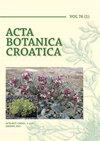Phytoplankton metrics for trophic and ecological status assessment of a natural karstic lake
IF 0.7
4区 生物学
Q3 PLANT SCIENCES
引用次数: 2
Abstract
According to the Water Framework Directive (WFD), biological quality elements constitute the basis for assessing ecological status of surface waters. Biological communities are good indicators of water quality because they reflect environmental conditions over time and do not require frequent sampling. The main aims were to assess trophic and ecological status of the Lake Visovac (Krka River hydrosystem, South Croatia) using phytoplankton together with supportive physico-chemical parameters, eutrophication status and impact indicators. We also tested the viability of Chlorophyll-a (Chl-a) and Hungarian Lake Phytoplankton Index (HLPI) as proposed metrics in the standard regulatory monitoring procedure. The phytoplankton samples, Chl-a and physical- chemical parameters were taken on a monthly basis from April to September in 2016 and 2019. In 2016, the most dominant species was Pantocsekiella ocellata (Pantocsek) K.T.Kiss & Ács, while in 2019 it was accompanied by Ceratium hirundinella (O.F.Müller) Dujardin. According to Chl-a, Lake Visovac was within the limits of oligo- to mesotrophic status. Based on the HLPI index, the Lake ecological status was assessed as Good. Chl-a showed a statistically significant positive correlation with temperature, while HLPI was positively correlated with oxygen and Secchi depth. We propose the use of Chl-a for rapid bioassessment on a weekly basis, whilst more complex HLPI index should be applied monthly. Further improving the confidence level of the metrics used to assess the ecological status and a comprehensive revision of boundaries for included indicators is of fundamental importance.天然喀斯特湖营养与生态状况评价的浮游植物指标
根据水框架指令(WFD),生物质量要素构成了评估地表水生态状况的基础。生物群落是水质的良好指标,因为它们反映了一段时间内的环境条件,不需要频繁采样。主要目的是利用浮游植物以及支持性理化参数、富营养化状况和影响指标来评估Visovac湖(Krka河水系,克罗地亚南部)的营养和生态状况。我们还测试了作为标准监管监测程序中建议指标的叶绿素-a (Chl-a)和匈牙利湖浮游植物指数(HLPI)的生存能力。2016年和2019年4 - 9月逐月采集浮游植物样本、Chl-a和理化参数。2016年最优势种为Pantocsekiella ocellata (Pantocsek) k.t.k kiss & Ács, 2019年伴生有Ceratium hirundinella (o.f.m ller) Dujardin。根据chl -a,维索瓦茨湖处于低营养到中营养状态的范围内。基于HLPI指数,评价湖泊生态状况为良好。Chl-a与温度呈正相关,HLPI与氧、Secchi深度呈正相关。我们建议每周使用Chl-a进行快速生物评价,而更复杂的HLPI指数应每月应用。进一步提高用于评估生态状况的指标的置信度和全面修订所包括指标的边界是至关重要的。
本文章由计算机程序翻译,如有差异,请以英文原文为准。
求助全文
约1分钟内获得全文
求助全文
来源期刊

Acta Botanica Croatica
PLANT SCIENCES-
CiteScore
2.50
自引率
0.00%
发文量
34
审稿时长
>12 weeks
期刊介绍:
The interest of the journal is field (terrestrial and aquatic) and experimental botany (including microorganisms, plant viruses, bacteria, unicellular algae), from subcellular level to ecosystems. The attention of the Journal is aimed to the research of karstic areas of the southern Europe, karstic waters and the Adriatic Sea (Mediterranean).
 求助内容:
求助内容: 应助结果提醒方式:
应助结果提醒方式:


